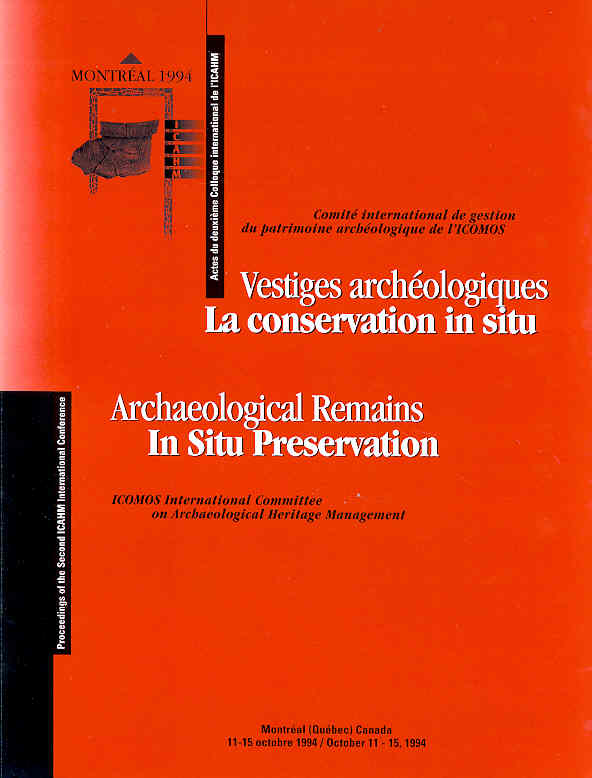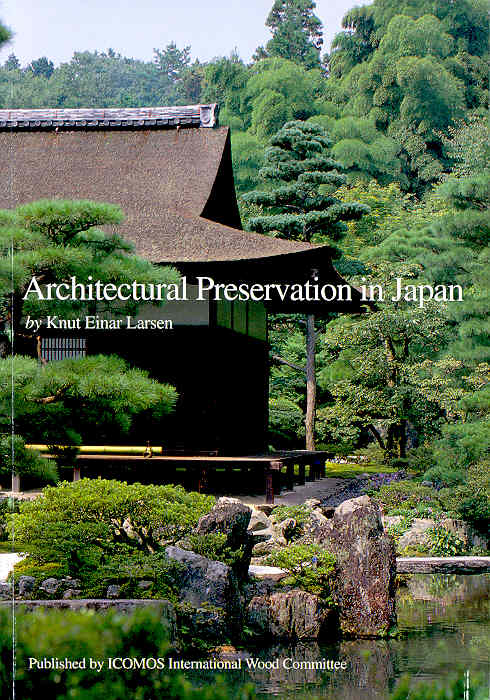
1994
417 pages
15,00 Euros
Table des matières
Table of Contents
Présentation de l'ICOMOS et de l'ICAHM/Presentation of ICOMOS and ICAHM
Avant-propos/Foreword
Mme Claire Mousseau, Responsable du programme scientifique et de l'édition, Canada
Les allocution d'ouverture / Opening Ad dresses
Dr. Pierre Nadon, Président de I'ICAHM, Canada: Mot de bienvenue
Dr. Jack Brink, Canada: An Example of In Situ Preservation of Archaeological Resources. A UNESCO World Heritage Site. Head-Smashed-In Buffalo Jump
La séance thématique d'ouverture/Opening Thematic Session
Dr. Francis P. McManamon, United States: Mot d'introduction- Thème A/lntroductory Words- Theme A
Dr. Gustaf Trotzig, Sweden: Mot d'introduction- Thème B/lntroductory Words- Theme B
Ms. Marilyn Truscott, Australia: Mot d'introduction- Thème C/lntroductory Words- Theme C
Atelier A: Les composantes du processus de la conservation
Workshop A: Components of the Preservation Process
Mrs. Lucija Azman Momirski, Slovenia: Interpreting the Site. Archaeological Presentation between Project and Audience
Mrs. Müge Bahçeci, Turkey: The Pamukkale's Preservation and Development Plan
M. Jean-Guy Brossard, Canada: Pointe-à-Callière, musée d'archéologie et d'histoire de Montréal. La conservation de sites archéologiques de A à z
Mr. Scott Cunliffe, United States: Documentation as a Management Tool. Planning for Conservation
Mme Catherine Drouin, avec la collaboration du Dr. Laurier Turgeon, Canada: L'Île aux Basques. Reconstitution et remémoration
Mmes Mathilde Lavenu et Victorine Mataouchek, France: La ville de Leuven, Belgique. Les vestiges de l'enceinte du 129 siècle
Dr. Paul McMahon,Ireland: Archaeological Sites in Ireland. Conservation, Maintenance and Enhancement
Dr. Giuseppe Morganti, Italie, Dans la banlieue de Rome. La conservation d'un paysage préhistorique
Mrs. Teresa C. Patricio, Portugal, with the collaboration of Dr. Koen Van Balen,Belgium: The Nymphaeum at Sagalassos, Turkey.The Anastylosis and the Applicability
Ms. Annika Richert, Sweden: A Visitors Centre at Birka.The first Viking Settlement in Sweden
Mr. Brian D. Ross, Canada: In Pukaskwa National Park, Ontario, Canada. Monitoring and Protection of Mysterious Stone Structures
Dr. Mario Sanoja, Venezuela: The Guayana Project. In Situ Museums and Education
Mrs. Roxana Seguel, Chile: In the Semi-Arid Region of Chile. Diagnosis for the Conservation of Archaeological Sites
M. Hung Trân, Vietnam: La conservation du patrimoine urbain à Hanoi
Dr. Antonio Varone, Italie: La maison pompéienne des Casti Amanti. Fouille, documentation et conservation
Atelier B : Les stratégies dans les choix des lieux et des éléments à conserver à l'intérieur des sites
Workshop B: Strategies for the Selection of Places and Elements to Conserve within Sites
Dr. Daniel Arsenault et M. Louis Gagnon, Canada: Le site Nisula, Haute-Côte-Nord du Québec. Le défi de la conservation d'un site à pictogrammes
Mme Isabelle Biraud-Burot, France: Retrouver le sens de la ville
Dr. Dan Carlsson, Sweden: Follow the Vikings! How to Highlight the World of the Vikings
Mme Rosa Enguix Alemany, Espagne: La Communauté Valencienne. Mise en valeur de vestiges archéologiques
Mme Cristina lamandi, Canada : Entre la mise en valeur et l'enfouissement. Alternatives de conservation des vestiges archéologiques in situ
M. Dominique Leconte, France: De la fouille au projet
M. Alain Gilles Magdinier, France: Dans une bergerie de montagne, Alpes-de-Haute-Provence, France. Conservation et présentation des vestiges d'un mausolée antique
Mrs. Marisa Mastroroberto, Italia: The House of C. Julius Polibius in Pompei. Reasons of Restoration
Mr. Roberto Morales Juarez with the collaboration of Mrs. Maria Elena Molina Soto, Guatemala: In Central America. Archaeological Heritage and Sustainable Oevelopment Planning
Dr. Peter Pope, Canada : Under Water Street. The Early Waterfront of St. John's, Newfoundland
Mr. Marko Stokin, Slovenia: Interpretation of a Roman Villa. Research Strategies and Presentation
Dr. Marianne P. Stopp, Canada: Cultural Bias in Heritage Reconstruction
Dr. Robert M. Thorne, United States: Archaeological Site Preservation as an Appropriate and Useful Management Tool
Dr. Iraida Vargas Arenas, Venezuela : In the City of Caracas, Venezuela. The Project of Urban Archaeology
M. Stéphane Vermette, Canada: le corps archéologique
Mr. Kjeld Borch Vesth, Denmark: Preservation and Presentation of Ancient Monuments in Denmark
Mr. Alan Watchman, Canada: Assessing the Condition of Prehistoric Rock Art Sites for Heritage Management Plans
Dr. Gonzalo Yanes Diaz, Mexico: The Case of Cuetzalan and Yohualichan. Puebla. Mexico. Archaeology and Tourism. Should They Be Integrated?
Atelier C : Le rôle des intervenants et des clients
Workshop C : Role and Contributors and Clients
M. André Bergeron, Canada: Archéologie et conservation. Convergence ou divergence?
Mme Michelle Guitard, Canada: l'histoire et la mise en valeur des sites archéologiques en Asie
Mr. George Hasemann, Honduras: Archaeological Parks in Honduras. Realities of Research and Responsability
Dr. Nicky Horsfal1, Australia: Bare Hil1 Rock Art Sites, North Queensland. Australia. Co-operation in Indigenous Site Management
Mmes Annabel1e Laliberté et Marie - Thérèse Landry, Canada: Dans les projets de mise en valeur de sites archéologiques. la pertinence de J'apport des arts comme discipline
M. Gérald McNichols Tétreault, Canada: Récurrences archéologiques
Mr. Peter J. Priess, Canada : The York Factory Example. Archaeology in Support of Building Restoration
Dr. Andrzej Prinke, Poland : Landscape Parks in Poland. A Multidisciplinary Approach to Natural and Cultural Resources
La syntèse des ateliers thématiques/Synthesis of the Thematic Workshops
Dr. Norman Clermont, Canada: Synthèse des débats de J'atelier A. Synthesis of the Debates. Workshop A
Dr. Gustaf Trotzig, Sweden: Synthèse des débats de J'atelier B Synthesis of the Debates, Workshop B
Ms. Marilyn Truscott, Australia: Synthèse des débats de l'atelier C. Synthesis of the Debates. Workshop C
La Conférence de clôture/Closing Lecture
M. François Leblan, Président d'ICOMOS, Canada
ICAHM/Procès-verbal de l'Assemblée générale du 15 octobre 1994
ICAHM/Minutes of the General Assembly, Saturday October 15, 1994
Procès-verbal/Minutes
liste des représentants de L'ICAHM/list of ICAHM representatives
Les participants inscrits au Colloque international ICAHM Montréal 1994
Les commanditaires



